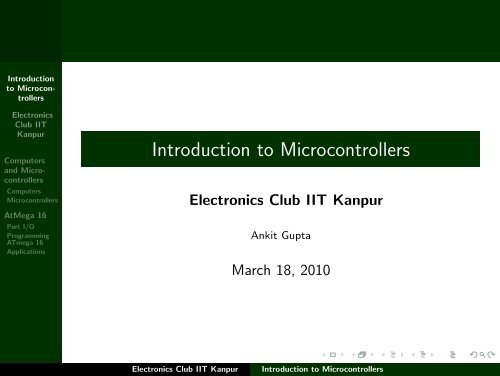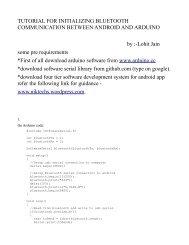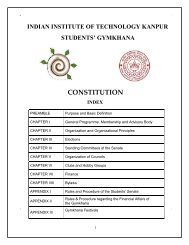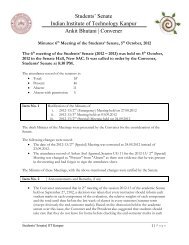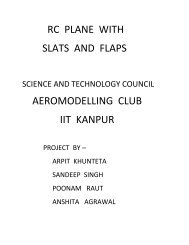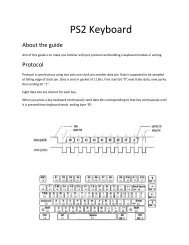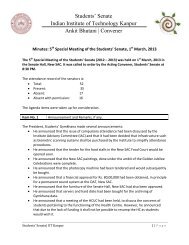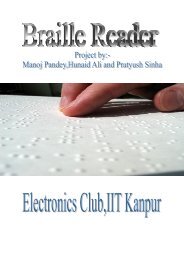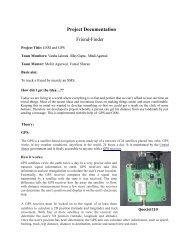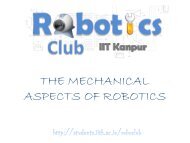Introduction to Microcontrollers
Introduction to Microcontrollers
Introduction to Microcontrollers
Create successful ePaper yourself
Turn your PDF publications into a flip-book with our unique Google optimized e-Paper software.
<strong>Introduction</strong><br />
<strong>to</strong> <strong>Microcontrollers</strong><br />
Electronics<br />
Club IIT<br />
Kanpur<br />
Computers<br />
and <strong>Microcontrollers</strong><br />
Computers<br />
<strong>Microcontrollers</strong><br />
AtMega 16<br />
Port I/O<br />
Programming<br />
ATmega 16<br />
Applications<br />
<strong>Introduction</strong> <strong>to</strong> <strong>Microcontrollers</strong><br />
Electronics Club IIT Kanpur<br />
Ankit Gupta<br />
March 18, 2010<br />
Electronics Club IIT Kanpur<br />
<strong>Introduction</strong> <strong>to</strong> <strong>Microcontrollers</strong>
Aim of this lecture<br />
<strong>Introduction</strong><br />
<strong>to</strong> <strong>Microcontrollers</strong><br />
Electronics<br />
Club IIT<br />
Kanpur<br />
Computers<br />
and <strong>Microcontrollers</strong><br />
Computers<br />
<strong>Microcontrollers</strong><br />
AtMega 16<br />
Port I/O<br />
Programming<br />
ATmega 16<br />
Applications<br />
What are the <strong>Microcontrollers</strong><br />
Electronics Club IIT Kanpur<br />
<strong>Introduction</strong> <strong>to</strong> <strong>Microcontrollers</strong>
Aim of this lecture<br />
<strong>Introduction</strong><br />
<strong>to</strong> <strong>Microcontrollers</strong><br />
Electronics<br />
Club IIT<br />
Kanpur<br />
Computers<br />
and <strong>Microcontrollers</strong><br />
Computers<br />
<strong>Microcontrollers</strong><br />
AtMega 16<br />
Port I/O<br />
Programming<br />
ATmega 16<br />
Applications<br />
What are the <strong>Microcontrollers</strong><br />
Applications of <strong>Microcontrollers</strong><br />
Electronics Club IIT Kanpur<br />
<strong>Introduction</strong> <strong>to</strong> <strong>Microcontrollers</strong>
Aim of this lecture<br />
<strong>Introduction</strong><br />
<strong>to</strong> <strong>Microcontrollers</strong><br />
Electronics<br />
Club IIT<br />
Kanpur<br />
Computers<br />
and <strong>Microcontrollers</strong><br />
Computers<br />
<strong>Microcontrollers</strong><br />
AtMega 16<br />
Port I/O<br />
Programming<br />
ATmega 16<br />
Applications<br />
What are the <strong>Microcontrollers</strong><br />
Applications of <strong>Microcontrollers</strong><br />
How <strong>to</strong> program a Micocontroller<br />
Electronics Club IIT Kanpur<br />
<strong>Introduction</strong> <strong>to</strong> <strong>Microcontrollers</strong>
Contents<br />
<strong>Introduction</strong><br />
<strong>to</strong> <strong>Microcontrollers</strong><br />
Electronics<br />
Club IIT<br />
Kanpur<br />
Computers<br />
and <strong>Microcontrollers</strong><br />
Computers<br />
<strong>Microcontrollers</strong><br />
AtMega 16<br />
Port I/O<br />
Programming<br />
ATmega 16<br />
Applications<br />
1 Computers and <strong>Microcontrollers</strong><br />
Computers<br />
<strong>Microcontrollers</strong><br />
2 AtMega 16<br />
Port I/O<br />
Programming ATmega 16<br />
Applications<br />
Electronics Club IIT Kanpur<br />
<strong>Introduction</strong> <strong>to</strong> <strong>Microcontrollers</strong>
Computers<br />
<strong>Introduction</strong><br />
<strong>to</strong> <strong>Microcontrollers</strong><br />
Electronics<br />
Club IIT<br />
Kanpur<br />
Computers<br />
and <strong>Microcontrollers</strong><br />
Computers<br />
<strong>Microcontrollers</strong><br />
AtMega 16<br />
Port I/O<br />
Programming<br />
ATmega 16<br />
Applications<br />
Visibly distinguishable parts :<br />
CPU Data Processing, S<strong>to</strong>rage, Power Distribution ,Hard<br />
Disk<br />
I/O Devices Keyboard, Mouse, Moni<strong>to</strong>r, etc<br />
USB/Serial/Parallel Port<br />
Electronics Club IIT Kanpur<br />
<strong>Introduction</strong> <strong>to</strong> <strong>Microcontrollers</strong>
Microprocessor<br />
<strong>Introduction</strong><br />
<strong>to</strong> <strong>Microcontrollers</strong><br />
Electronics<br />
Club IIT<br />
Kanpur<br />
Computers<br />
and <strong>Microcontrollers</strong><br />
Computers<br />
<strong>Microcontrollers</strong><br />
AtMega 16<br />
Port I/O<br />
Programming<br />
ATmega 16<br />
Applications<br />
Figure: Pentium 4<br />
Capable of doing<br />
thousands of<br />
boolean operations<br />
every second<br />
NO STORAGE<br />
MEMORY<br />
NO<br />
INPUT/OUTPUT<br />
DEVICE<br />
Only pins<br />
Present speed ?<br />
Electronics Club IIT Kanpur<br />
<strong>Introduction</strong> <strong>to</strong> <strong>Microcontrollers</strong>
Lets shrink it <strong>to</strong> a chip<br />
<strong>Introduction</strong><br />
<strong>to</strong> <strong>Microcontrollers</strong><br />
Electronics<br />
Club IIT<br />
Kanpur<br />
Computers<br />
and <strong>Microcontrollers</strong><br />
Computers<br />
<strong>Microcontrollers</strong><br />
AtMega 16<br />
Port I/O<br />
Programming<br />
ATmega 16<br />
Applications<br />
Computers <strong>Microcontrollers</strong><br />
RAM Working Registers<br />
Memory<br />
Hard Disk<br />
Kbd/Mouse/Moni<strong>to</strong>r I/O Pins<br />
Serial/Parallel/USB USART/SPI<br />
Read following article on wikipedia<br />
http://en.wikipedia.org/wiki/Microcontroller<br />
Electronics Club IIT Kanpur<br />
<strong>Introduction</strong> <strong>to</strong> <strong>Microcontrollers</strong>
<strong>Microcontrollers</strong><br />
<strong>Introduction</strong><br />
<strong>to</strong> <strong>Microcontrollers</strong><br />
Electronics<br />
Club IIT<br />
Kanpur<br />
What are <strong>Microcontrollers</strong>?<br />
Integrated Circuits (ICs)<br />
Computers<br />
and <strong>Microcontrollers</strong><br />
Computers<br />
<strong>Microcontrollers</strong><br />
AtMega 16<br />
Port I/O<br />
Programming<br />
ATmega 16<br />
Applications<br />
Electronics Club IIT Kanpur<br />
<strong>Introduction</strong> <strong>to</strong> <strong>Microcontrollers</strong>
<strong>Microcontrollers</strong><br />
<strong>Introduction</strong><br />
<strong>to</strong> <strong>Microcontrollers</strong><br />
Electronics<br />
Club IIT<br />
Kanpur<br />
Computers<br />
and <strong>Microcontrollers</strong><br />
Computers<br />
<strong>Microcontrollers</strong><br />
AtMega 16<br />
Port I/O<br />
Programming<br />
ATmega 16<br />
Applications<br />
What are <strong>Microcontrollers</strong>?<br />
Integrated Circuits (ICs)<br />
Programmable You can define what they do.<br />
This is what makes them different from other simpler ICs,<br />
such as AND gates, inverters, etc<br />
Logic tables relating Input and Output can be defined by<br />
you<br />
Electronics Club IIT Kanpur<br />
<strong>Introduction</strong> <strong>to</strong> <strong>Microcontrollers</strong>
<strong>Microcontrollers</strong><br />
<strong>Introduction</strong><br />
<strong>to</strong> <strong>Microcontrollers</strong><br />
Electronics<br />
Club IIT<br />
Kanpur<br />
Computers<br />
and <strong>Microcontrollers</strong><br />
Computers<br />
<strong>Microcontrollers</strong><br />
AtMega 16<br />
Port I/O<br />
Programming<br />
ATmega 16<br />
Applications<br />
What are <strong>Microcontrollers</strong>?<br />
Integrated Circuits (ICs)<br />
Programmable You can define what they do.<br />
This is what makes them different from other simpler ICs,<br />
such as AND gates, inverters, etc<br />
Logic tables relating Input and Output can be defined by<br />
you<br />
Many useful features built in <strong>to</strong> the uC itself<br />
This is what makes them different from the processors on<br />
a computer (called a microprocessor)<br />
Many of the simpler features built in<strong>to</strong> a motherboard are<br />
located in the microcontroller itself, making it<br />
self-sufficient.<br />
Electronics Club IIT Kanpur<br />
<strong>Introduction</strong> <strong>to</strong> <strong>Microcontrollers</strong>
Microcontroller in Everyday Life<br />
<strong>Introduction</strong><br />
<strong>to</strong> <strong>Microcontrollers</strong><br />
Electronics<br />
Club IIT<br />
Kanpur<br />
Computers<br />
and <strong>Microcontrollers</strong><br />
Computers<br />
<strong>Microcontrollers</strong><br />
AtMega 16<br />
Port I/O<br />
Programming<br />
ATmega 16<br />
Applications<br />
Figure: Applications<br />
Electronics Club IIT Kanpur<br />
<strong>Introduction</strong> <strong>to</strong> <strong>Microcontrollers</strong>
Microcontroller in Everyday Life<br />
<strong>Introduction</strong><br />
<strong>to</strong> <strong>Microcontrollers</strong><br />
Electronics<br />
Club IIT<br />
Kanpur<br />
Computers<br />
and <strong>Microcontrollers</strong><br />
Computers<br />
<strong>Microcontrollers</strong><br />
AtMega 16<br />
Port I/O<br />
Programming<br />
ATmega 16<br />
Applications<br />
Figure: Application of Microcontroller in Au<strong>to</strong>mobile<br />
Electronics Club IIT Kanpur<br />
<strong>Introduction</strong> <strong>to</strong> <strong>Microcontrollers</strong>
Microcontroller in Everyday Life<br />
<strong>Introduction</strong><br />
<strong>to</strong> <strong>Microcontrollers</strong><br />
Electronics<br />
Club IIT<br />
Kanpur<br />
Computers<br />
and <strong>Microcontrollers</strong><br />
Computers<br />
<strong>Microcontrollers</strong><br />
AtMega 16<br />
Port I/O<br />
Programming<br />
ATmega 16<br />
Applications<br />
Figure: Example of Microwave oven<br />
Electronics Club IIT Kanpur<br />
<strong>Introduction</strong> <strong>to</strong> <strong>Microcontrollers</strong>
Microcontroller in Everyday Life<br />
<strong>Introduction</strong><br />
<strong>to</strong> <strong>Microcontrollers</strong><br />
Electronics<br />
Club IIT<br />
Kanpur<br />
Computers<br />
and <strong>Microcontrollers</strong><br />
Computers<br />
<strong>Microcontrollers</strong><br />
AtMega 16<br />
Port I/O<br />
Programming<br />
ATmega 16<br />
Applications<br />
Doesn’t need a monster with 3.2 GHz Intel Core 2 Quad<br />
extreme processor with 2 GB Dual channed DDR3 RAM,<br />
320 GB HDD and Dedicated nVIDIA GEFORCE graphics<br />
!!!.<br />
What is of main concern is cost and size.<br />
What it will be running through out its life is a simple<br />
program that is hardly more than 4KB in size, requiring<br />
less than 128 Bytes of RAM <strong>to</strong> s<strong>to</strong>re few varriables<br />
Electronics Club IIT Kanpur<br />
<strong>Introduction</strong> <strong>to</strong> <strong>Microcontrollers</strong>
AtMega 16<br />
<strong>Introduction</strong><br />
<strong>to</strong> <strong>Microcontrollers</strong><br />
Electronics<br />
Club IIT<br />
Kanpur<br />
Computers<br />
and <strong>Microcontrollers</strong><br />
Computers<br />
<strong>Microcontrollers</strong><br />
AtMega 16<br />
Port I/O<br />
Programming<br />
ATmega 16<br />
Applications<br />
40 Pins<br />
4 PORTs<br />
A,B,C,D<br />
4X8 I/O pins<br />
Electronics Club IIT Kanpur<br />
<strong>Introduction</strong> <strong>to</strong> <strong>Microcontrollers</strong>
Ports<br />
<strong>Introduction</strong><br />
<strong>to</strong> <strong>Microcontrollers</strong><br />
Electronics<br />
Club IIT<br />
Kanpur<br />
Computers<br />
and <strong>Microcontrollers</strong><br />
Computers<br />
<strong>Microcontrollers</strong><br />
AtMega 16<br />
Port I/O<br />
Programming<br />
ATmega 16<br />
Applications<br />
Electronics Club IIT Kanpur<br />
<strong>Introduction</strong> <strong>to</strong> <strong>Microcontrollers</strong>
Registers<br />
<strong>Introduction</strong><br />
<strong>to</strong> <strong>Microcontrollers</strong><br />
Electronics<br />
Club IIT<br />
Kanpur<br />
Computers<br />
and <strong>Microcontrollers</strong><br />
Computers<br />
<strong>Microcontrollers</strong><br />
AtMega 16<br />
Port I/O<br />
Programming<br />
ATmega 16<br />
Applications<br />
The ports are bi-directional: Each pin can be individually<br />
configured for input or output.<br />
For each port (x = A, B, C or D), there are three relevant<br />
registers.<br />
DDRx<br />
set a specific port pin <strong>to</strong> output (1) or input (0)<br />
PINx<br />
<strong>to</strong> read input data from port<br />
PORTx<br />
<strong>to</strong> write output data <strong>to</strong> port<br />
Electronics Club IIT Kanpur<br />
<strong>Introduction</strong> <strong>to</strong> <strong>Microcontrollers</strong>
Examples<br />
<strong>Introduction</strong><br />
<strong>to</strong> <strong>Microcontrollers</strong><br />
Electronics<br />
Club IIT<br />
Kanpur<br />
Computers<br />
and <strong>Microcontrollers</strong><br />
Computers<br />
<strong>Microcontrollers</strong><br />
AtMega 16<br />
Port I/O<br />
Programming<br />
ATmega 16<br />
Applications<br />
x=A,B,C,D<br />
DDRx<br />
DDRA=00001111; or DDRA=0x0F;<br />
Pin 0,1,2,3 PORTA assigned as output and pin 4,5,6,7 as<br />
output<br />
PINx<br />
DDRB.0=0;<br />
first assign Pin o of port B as input a=PINB.0;<br />
a will s<strong>to</strong>re the current value of Pin 0 of port B<br />
PORTx<br />
DDRA=0xFF or DDRA=11111111;<br />
first assign Port A as output PORTA=0xD7; or<br />
PORTA=11010111;<br />
pin 0,1,2,4,6,7<br />
Electronics Club<br />
willIIThave Kanpuroutput <strong>Introduction</strong><br />
high<br />
<strong>to</strong>and <strong>Microcontrollers</strong><br />
pin 3 and 5 will have
Let’s write a code<br />
<strong>Introduction</strong><br />
<strong>to</strong> <strong>Microcontrollers</strong><br />
Electronics<br />
Club IIT<br />
Kanpur<br />
Computers<br />
and <strong>Microcontrollers</strong><br />
Computers<br />
<strong>Microcontrollers</strong><br />
AtMega 16<br />
Port I/O<br />
Programming<br />
ATmega 16<br />
Applications<br />
Problem:<br />
Suppose we want <strong>to</strong> this led glow for 500 ms and remain off for<br />
500 ms and repeat and assume led is connected <strong>to</strong> PORTA.0<br />
Electronics Club IIT Kanpur<br />
<strong>Introduction</strong> <strong>to</strong> <strong>Microcontrollers</strong>
<strong>Introduction</strong><br />
<strong>to</strong> <strong>Microcontrollers</strong><br />
Electronics<br />
Club IIT<br />
Kanpur<br />
Computers<br />
and <strong>Microcontrollers</strong><br />
Computers<br />
<strong>Microcontrollers</strong><br />
AtMega 16<br />
Port I/O<br />
Programming<br />
ATmega 16<br />
Applications<br />
Code<br />
void main()<br />
{<br />
DDRA=0x00;// or DDRA.0=0<br />
}<br />
{<br />
PORTA=0b00000001;<br />
delay_ms(500);<br />
PORTA=0b00000000;<br />
delay_ms(500);<br />
}<br />
SetPortDirection();<br />
will it blink once ?<br />
Electronics Club IIT Kanpur<br />
<strong>Introduction</strong> <strong>to</strong> <strong>Microcontrollers</strong>
<strong>Introduction</strong><br />
<strong>to</strong> <strong>Microcontrollers</strong><br />
Electronics<br />
Club IIT<br />
Kanpur<br />
Computers<br />
and <strong>Microcontrollers</strong><br />
Computers<br />
<strong>Microcontrollers</strong><br />
AtMega 16<br />
Port I/O<br />
Programming<br />
ATmega 16<br />
Applications<br />
Introduce a while loop<br />
void main()<br />
{<br />
DDRA=0x00;// or DDRA.0=0<br />
while(1)<br />
{<br />
PORTA=0b00000001;<br />
delay_ms(500);<br />
PORTA=0b00000000;<br />
delay_ms(500);<br />
}<br />
}<br />
SetPortDirection();<br />
Electronics Club IIT Kanpur<br />
<strong>Introduction</strong> <strong>to</strong> <strong>Microcontrollers</strong>
More coding<br />
<strong>Introduction</strong><br />
<strong>to</strong> <strong>Microcontrollers</strong><br />
1.Binary number display<br />
Electronics<br />
Club IIT<br />
Kanpur<br />
Computers<br />
and <strong>Microcontrollers</strong><br />
Computers<br />
<strong>Microcontrollers</strong><br />
AtMega 16<br />
Port I/O<br />
Programming<br />
ATmega 16<br />
Applications<br />
Electronics Club IIT Kanpur<br />
<strong>Introduction</strong> <strong>to</strong> <strong>Microcontrollers</strong>
More coding<br />
<strong>Introduction</strong><br />
<strong>to</strong> <strong>Microcontrollers</strong><br />
2.Moving train pattern<br />
Electronics<br />
Club IIT<br />
Kanpur<br />
Computers<br />
and <strong>Microcontrollers</strong><br />
Computers<br />
<strong>Microcontrollers</strong><br />
AtMega 16<br />
Port I/O<br />
Programming<br />
ATmega 16<br />
Applications<br />
Electronics Club IIT Kanpur<br />
<strong>Introduction</strong> <strong>to</strong> <strong>Microcontrollers</strong>
How <strong>to</strong> Program a Microcontroller<br />
<strong>Introduction</strong><br />
<strong>to</strong> <strong>Microcontrollers</strong><br />
Electronics<br />
Club IIT<br />
Kanpur<br />
Computers<br />
and <strong>Microcontrollers</strong><br />
Computers<br />
<strong>Microcontrollers</strong><br />
AtMega 16<br />
Port I/O<br />
Programming<br />
ATmega 16<br />
Applications<br />
Steps are<br />
1 Create a project in CVAVR and writing a program in<br />
C<br />
CVAVR<br />
2 Convert/compile it in<strong>to</strong> machine language (.hex<br />
format)<br />
CVAVR<br />
3 Download the hex file in ATMega 16<br />
AVR Studio<br />
For uploading ,we need a programmer<br />
Electronics Club IIT Kanpur<br />
<strong>Introduction</strong> <strong>to</strong> <strong>Microcontrollers</strong>
More ..<br />
<strong>Introduction</strong><br />
<strong>to</strong> <strong>Microcontrollers</strong><br />
Electronics<br />
Club IIT<br />
Kanpur<br />
Computers<br />
and <strong>Microcontrollers</strong><br />
Computers<br />
<strong>Microcontrollers</strong><br />
AtMega 16<br />
Port I/O<br />
Programming<br />
ATmega 16<br />
Applications<br />
Timers<br />
ADC<br />
LCD(Character/Graphical/Mobile lcd)<br />
Mo<strong>to</strong>rs<br />
UART/SPI/I2c/PS2)<br />
EEPROM,MMC<br />
Electronics Club IIT Kanpur<br />
<strong>Introduction</strong> <strong>to</strong> <strong>Microcontrollers</strong>


